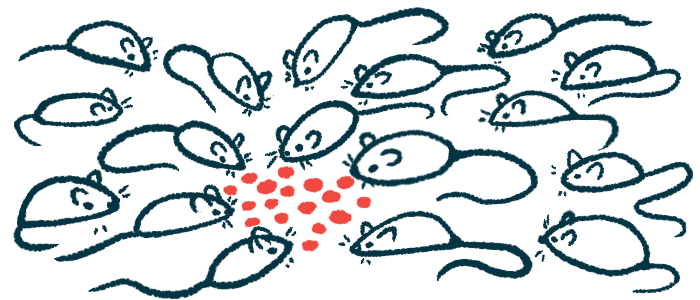Periods of oxygen deprivation improve symptoms of MS in mice
So-called AIH therapy may be a potential strategy for people: Study

A non-invasive treatment called acute intermittent hypoxia, or AIH, involving periods of oxygen deprivation, was found to ease signs and symptoms of progressive multiple sclerosis (MS) in a mouse model of the disease.
Given during the peak of disease activity, AIH treatment — basically, periods of reduced oxygen exposure — resulted in reduced inflammation and damage in the mice. The therapy also was seen to lower overall clinical scores and increase the repair of myelin, the protective coating on nerve fibers that is damaged in people with MS.
“The data support AIH as a novel non-invasive therapeutic strategy for progressive forms of MS where neuroprotection and repair are critical,” the researchers wrote.
These findings are important, the team noted, given that “research manipulating oxygen levels as a therapeutic strategy in MS preclinical models is sparse.”
The study, “Acute intermittent hypoxia alters disease course and promotes CNS repair including resolution of inflammation and remyelination in the experimental autoimmune encephalomyelitis model of MS,” was published in the journal Glia.
Oxygen deprivation treatment a novel approach to myelin repair
MS is marked by inflammation in the brain and spinal cord that causes damage to the myelin sheath. Such damage eventually leads to nerve cell loss and neurological disability.
AIH is an emerging non-invasive therapeutic approach with the potential to repair myelin and spinal cord damage. However, research examining its effects in MS is limited.
Now, scientists at the University of Saskatchewan, in Canada, tested such intermittent oxygen deprivation in mice with experimental autoimmune encephalomyelitis (EAE), a commonly used MS mouse model.
In particular, the team used an EAE version that resembles the features of progressive MS. Their hypothesis was that “AIH therapy begun at near peak disease, with parameters similar to those employed in humans, will enhance intrinsic repair mechanisms and attenuate disease progression.”
The MS mice were evaluated for functional deficits starting from symptom onset. When the animals reached a clinical score of 2.5 points, with is close to peak disease scores in these mice, AIH was started. Treatment consisted of 10 cycles of five minutes at 11% oxygen alternating with five minutes at 21% oxygen, given over two hours for seven days.
The results showed that MS mice always exposed to normal oxygen levels (21%) showed typical EAE disease progression. By contrast, those treated with AIH showed significant reductions in their clinical scores. Improvements were seen as early as one day after beginning treatment and continued throughout the remaining 14 days of the study.
As expected, the spinal cord tissue of the untreated mice showed signs of inflammation and extensive myelin loss, known as demyelination. In turn, AIH-treated mice had milder inflammation, more myelin, and more myelinated nerve fibers compared with controls.
This study supports AIH treatment as a novel and translatable therapeutic strategy with a tremendous capacity to enhance repair in demyelinating [brain and spinal cord] diseases such as MS.
The increased myelination was explained by the AIH-driven recruitment of precursors of oligodendrocytes, the cells that produce myelin, to areas of inflammation. As a result, an increase in mature oligodendrocytes able to produce myelin also was detected.
Significant benefits seen in mice given oxygen deprivation or AIH therapy
When nerve fibers lose myelin, proteins normally clustered at gaps, or nodes, between myelinated regions, disperse. AIH treatment promoted the re-clustering of these proteins, consistent with the re-formation of nodes, a sign of myelin repair.
Because nerve fiber injury ultimately leads to neurological disability in MS, the team examined levels of phosphorylated neurofilaments (pNF), which are known to protect fibers from degeneration.
The nerve fibers of MS mice kept at normal oxygen levels had little pNF and were less organized, “likely due to the high inflammation,” the team noted. In contrast, AIH-treated mice showed less pNF loss and fiber disorganization and had a reduced degree of inflammation.
Lastly, researchers looked for activated microglia, the brain’s resident immune cells. These cells are known to play a role in inflammation-related myelin damage, but can switch between pro-inflammatory and pro-repair states under certain conditions.
MS mice exposed to normal oxygen levels showed elevations in two pro-inflammatory biomarkers indicative of activated microglia. In comparison, seven days of AIH treatment significantly reduced both markers, by about 80%, while increasing the levels of two pro-repair markers by more than 100%.
“This study supports AIH treatment as a novel and translatable therapeutic strategy with a tremendous capacity to enhance repair in demyelinating [brain and spinal cord] diseases such as MS,” the researchers wrote.
For the team, these results were conclusive in showing the beneficial effects of oxygen deprivation as an MS treatment.
“As the degree of inflammation and myelin loss were already maximal before commencement of treatment and already significantly improved by AIH by the end of treatment, this supports it was a true repair response and not just mitigation of disease progression,” the team concluded.








